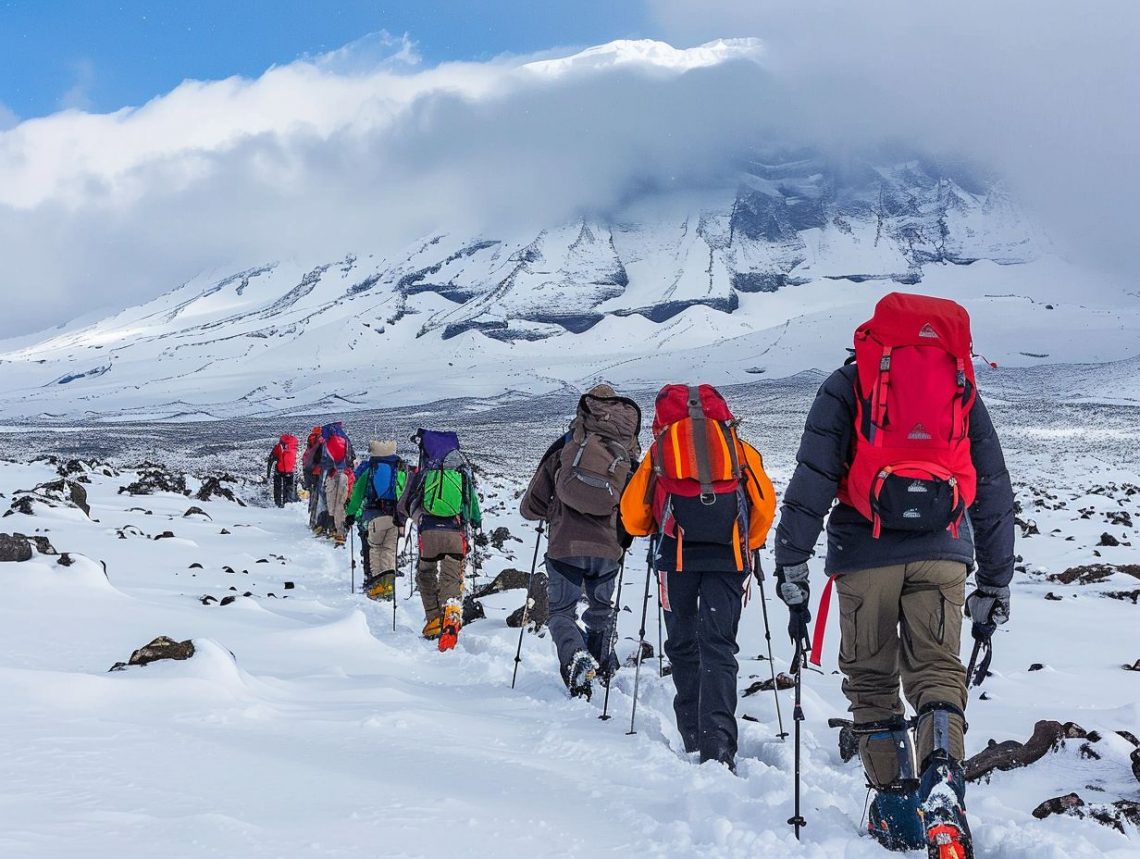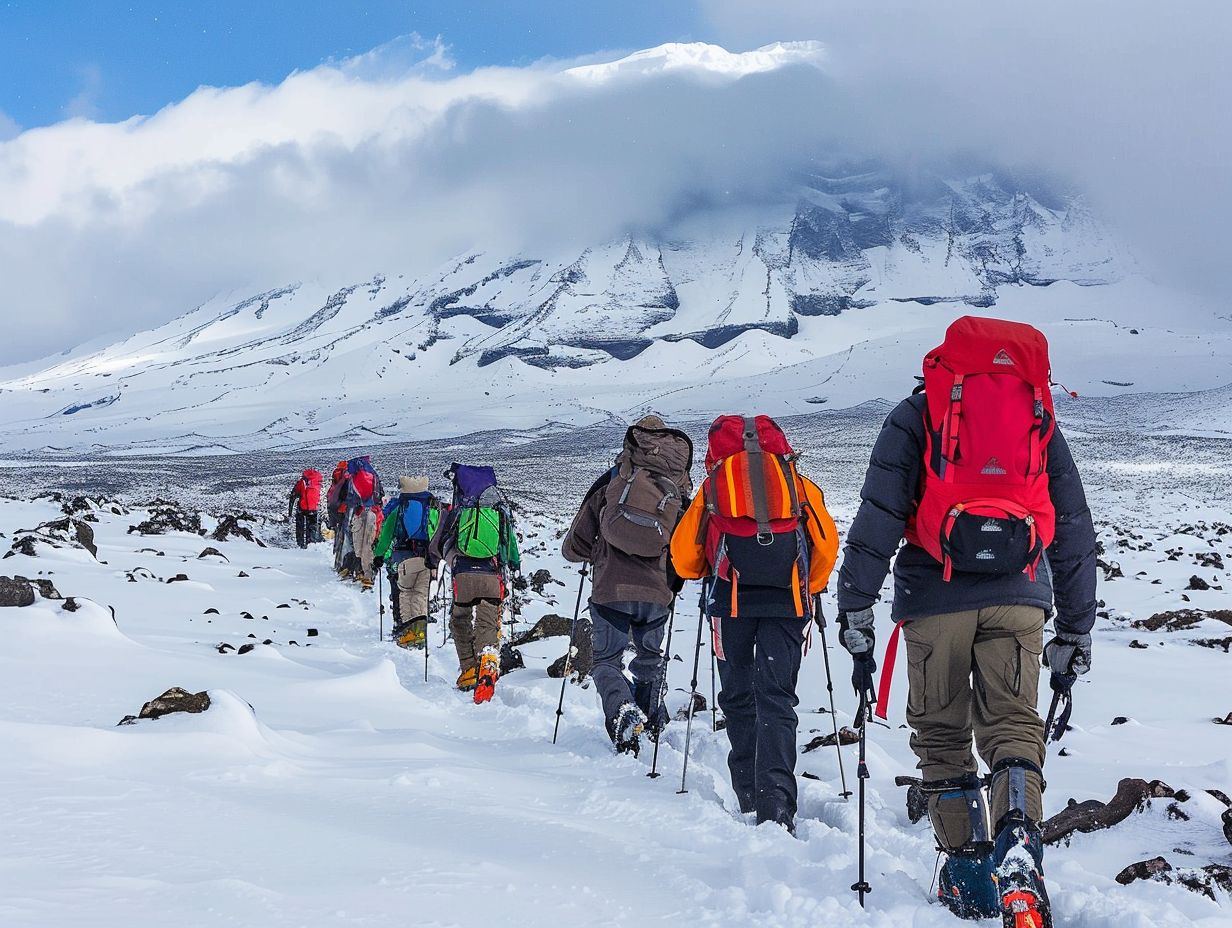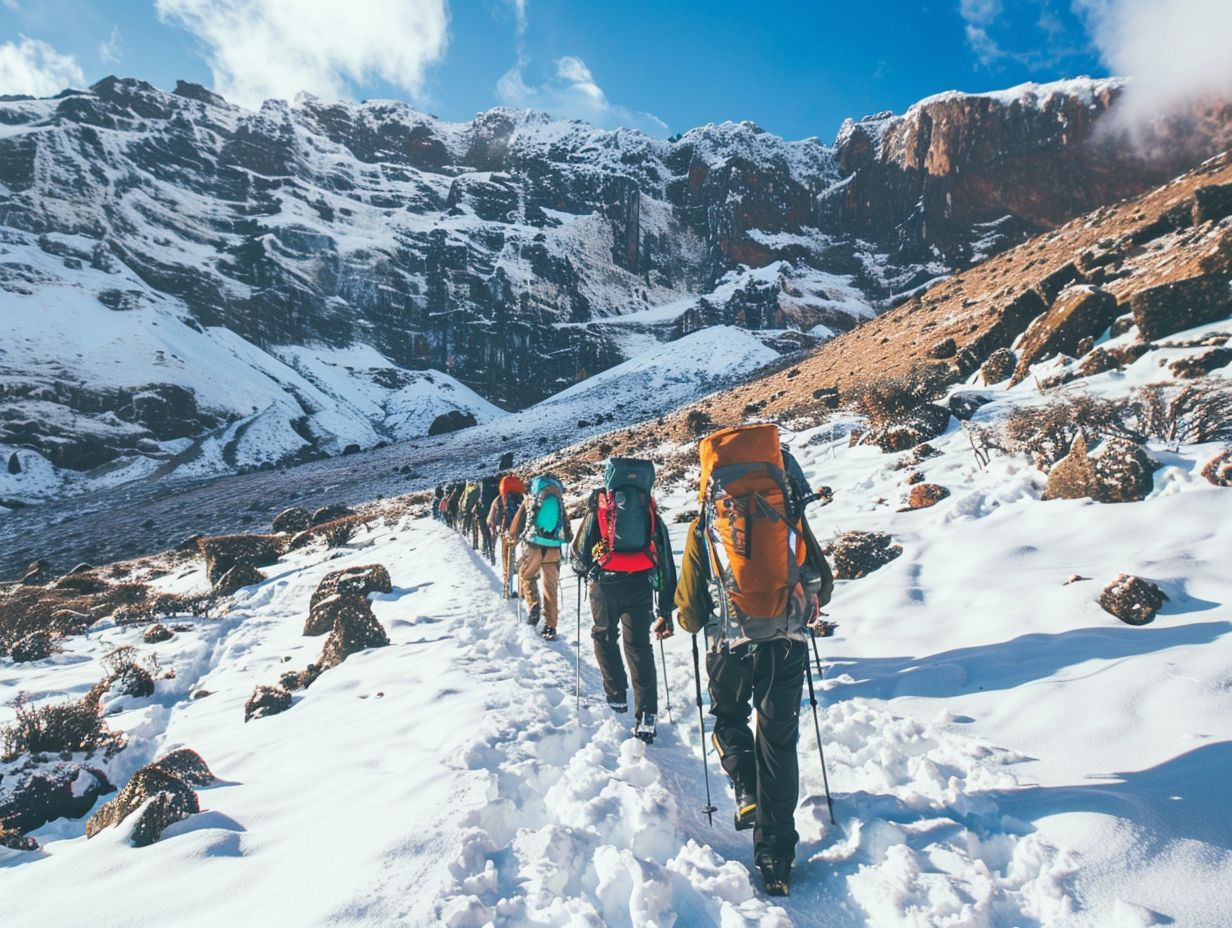
Kilimanjaro Guides
If you’ve ever dreamt of conquering the majestic Mount Kilimanjaro, you’ll know that a good guide is essential for a successful trek. But who are these Kilimanjaro guides, and what exactly do they do?
In this article, we’ll explore the roles of Kilimanjaro guides, the qualifications and training they have, the different types of guides available, how to choose a reliable guide, and the responsibilities of trekkers when hiking with a guide.
So, let’s dive into the world of Kilimanjaro guides and find out everything you need to know before embarking on your adventure.
Key Takeaways:

- Kilimanjaro guides play a crucial role in leading trekkers and ensuring their safety during the climb.
- Guides are highly trained and qualified, with certifications, first aid and rescue training, and language skills.
- When choosing a guide, it is important to research the company, read reviews, and communicate with the guide to ensure reliability and responsibility.
What Are the Roles of Kilimanjaro Guides?
Kilimanjaro guides play pivotal roles in ensuring the success and safety of trekkers aiming to reach the summit of the iconic mountain in Africa.
These experienced guides are responsible for not only leading the way up the challenging paths but also for providing valuable information about the mountain, its history, and the best practices for high-altitude trekking.
1. Leading the Way
Guides play a crucial role in leading trekkers along the designated routes, ensuring they stay on course and navigate the challenging terrain as they ascend the altitude of Kilimanjaro.
These experienced guides possess an in-depth knowledge of the ever-changing mountain paths, enabling them to choose the safest and most efficient routes for climbers.
Their ability to read the mountain’s subtle cues and weather patterns is essential in ensuring the group’s safety and successful summit.
They monitor climbers closely, offering support and guidance to help them manage the effects of high altitude, such as altitude sickness, and maintain a steady pace throughout the ascent.
Through their expertise, climbers can focus on the breathtaking views and unique experience of conquering Kilimanjaro.
2. Providing Information and Knowledge
Kilimanjaro guides offer valuable insights into the mountain’s ecology, volcanic history, and unique flora and fauna, enriching the trekking experience with their knowledge.
Guides on Kilimanjaro play a crucial role in not just leading climbers to the summit with their expertise, they delve into the geological formation of Kilimanjaro, explaining how it is a dormant stratovolcano with multiple cones.
These guides are well-versed in the diverse vegetation zones that climbers traverse through, such as the lush rainforest belt, heath, moorland, alpine desert, and arctic summit.
Their guidance includes pointing out various plant and animal species that are unique to these environments.
3. Ensuring Safety
Safety is paramount for Kilimanjaro guides, who are trained to assess risks, provide necessary equipment, and monitor trekkers’ health and acclimatization during the expedition.
Before setting off on the trek, they meticulously assess potential risks along the route, taking into account weather conditions, altitude challenges, and individual health considerations.
Equipped with this information, the guides meticulously prepare by packing essential gear such as helmets, ropes, and first aid kits, ensuring that trekkers are properly equipped for all scenarios.
They carefully monitor each climber’s symptoms of altitude sickness, providing oxygen support when needed to prevent any serious complications.
Constantly emphasizing the adherence to safety protocols, guides encourage gradual altitude adjustment to mitigate the risk of altitude sickness and other related dangers.
4. Managing Logistics
Kilimanjaro guides are responsible for coordinating logistics such as trek schedules, meal arrangements, accommodation bookings, and maintaining the expedition’s itinerary for a seamless climbing experience.
These guides play a crucial role in meticulously planning and executing the logistics involved in climbing one of the world’s highest peaks.
They work tirelessly to ensure that climbers have a well-structured journey up the mountain, starting from setting the daily trek schedules to arranging comfortable meal stops and overnight accommodations.
Kilimanjaro guides are adept at managing unexpected changes or challenges that may arise during the climb, swiftly rearranging plans to keep the expedition on track and ensuring the safety and satisfaction of the climbers.
What Qualifications and Training Do Kilimanjaro Guides Have?

Kilimanjaro guides possess a range of qualifications, certifications, and specialized training to ensure they are well-equipped to lead climbers on successful and safe expeditions.
These guides typically hold certifications in mountain guiding, indicating their expertise in navigating the challenging terrain of Kilimanjaro. They undergo rigorous first aid training to handle any emergencies.
Their deep understanding of the mountain’s unique challenges, such as altitude sickness and extreme weather conditions, is crucial in ensuring the safety and well-being of climbers.
With years of experience guiding treks on Kilimanjaro, these guides have honed their skills to offer invaluable support and guidance, making the ascent both safer and more enjoyable for adventurers.
Certifications and Licenses
Certifications and licenses are essential for Kilimanjaro guides, demonstrating their competence in leading expeditions, ensuring safety protocols, and providing quality guidance to climbers.
These certifications often include Wilderness First Responder (WFR) training, which equips guides to handle medical emergencies in remote mountainous terrain.
Guides must obtain a license from the Kilimanjaro National Park Authority, showcasing their compliance with local regulations and standards.
Those who possess qualifications from respected organizations like the International Federation of Mountain Guides Associations (IFMGA) or the Professional Mountaineering Instructors Association (PMIA).
First Aid and Rescue Training
First aid and rescue training are integral components of a Kilimanjaro guide’s preparation, equipping them with the skills to handle medical emergencies, altitude-related issues, and ensure prompt assistance to trekkers in need.
Guides undergo rigorous training to understand the symptoms of altitude sickness and other mountain-related ailments, enabling them to provide immediate care during expeditions.
Their proficiency in administering first aid can be life-saving for climbers facing health challenges. These guides are well-versed in rescue procedures, crucial for navigating the complexities of potential accidents or emergencies.
Language Skills
Language skills are essential for Kilimanjaro guides to effectively communicate with trekkers, provide instructions, share information, and facilitate seamless interactions during the expedition.
Having strong language proficiency enables guides to convey crucial safety measures, historical insights, and fascinating anecdotes, enriching the trekking experience for climbers.
Guides with diverse language abilities can cater to a broader spectrum of climbers, creating a welcoming environment for trekkers from different backgrounds.
What Are the Different Types of Kilimanjaro Guides?
There are various types of Kilimanjaro guides available, including private guides, group guides, and porter-guides, each offering unique benefits and services tailored to different preferences and expedition requirements.
1. Private Guides
Private guides offer personalized experiences for trekkers, providing individualized attention, customized itineraries, and expert guidance throughout the Kilimanjaro climb.
By hiring a private guide for your Kilimanjaro trek, you can benefit from their vast knowledge of the local terrain and conditions, ensuring a safe and enjoyable journey.
These guides are seasoned professionals who can adapt the climbing pace to suit your fitness level and preferences, making the ascent less daunting and more fulfilling.
With a private guide, you have the flexibility to adjust the itinerary based on your interests, physical condition, and acclimatization needs. This personalized approach not only enhances your overall trekking experience.
2. Group Guides
Group guides lead collective trekking expeditions on Kilimanjaro, offering shared experiences, group dynamics, and structured support for climbers seeking a collaborative adventure on the mountain.
These experienced guides play a vital role in ensuring that climbers reach the summit as well as fostering a sense of community, through organized group activities and shared challenges, guides can enhance the overall trekking experience.
Group guides are well-versed in the nuances of the terrain, weather conditions, and safety protocols, providing climbers with a sense of security and reassurance throughout the journey.
Their logistical expertise helps to streamline the expedition, allowing participants to focus on soaking in the breathtaking views and overcoming the physical and mental challenges of the climb.
3. Porter-guides

Porter-guides serve dual roles of carrying equipment and assisting climbers, contributing to the conservation of Kilimanjaro’s ecosystem while providing crucial support to trekking teams during the ascent.
These dedicated individuals act as not just guides but also as custodians of the mountain, maintaining its fragile ecosystem by adhering to sustainable practices.
Porter-guides play a vital role in promoting responsible tourism, ensuring that the environmental impact of expeditions remains minimal. Through their efforts in waste management and recycling, they help preserve.
How to Choose a Reliable and Responsible Kilimanjaro Guide?
Selecting a reliable and responsible Kilimanjaro guide is essential for a safe and successful climb, requiring thorough research, review assessment, certification verification, and effective communication with potential guides.
1. Research the Company
Before selecting a Kilimanjaro guide, it is essential to thoroughly research the guiding company, assess their experience, safety measures, and client reviews to ensure a reputable and reliable service provider.
Researching Kilimanjaro guiding companies is crucial as it can determine the success and safety of your trek. Examine the experience level of the guides provided by the company.
Experienced guides are well-versed in the terrain, weather conditions, and emergency procedures, offering a sense of confidence during the climb.
Safety measures are paramount when scaling Kilimanjaro. Look into the company’s safety protocols, including equipment standards, altitude sickness management, and emergency evacuation plans.
Delve into customer feedback to gauge the company’s reputation. Websites, forums, and social media platforms can offer valuable insights into the overall satisfaction levels of past climbers.
Positive reviews speak volumes about the company’s service quality and reliability.
2. Read Reviews and Testimonials
Reading reviews and testimonials from previous climbers can offer valuable insights into a Kilimanjaro guide’s performance, safety record, success rate, and overall client satisfaction, aiding in the selection process.
When researching, it’s crucial to delve into the experiences shared by those who have trekked the mountain before. By scrutinizing the feedback left by past climbers, you can gauge the reliability and professionalism of a guide.
These testimonials often contain details about the guide’s communication skills, attentiveness to safety protocols, the ability to handle emergencies, and the overall experience offered.
Peer reviews serve as a window into the guide’s reliability, the quality of service provided, and their commitment to ensuring a safe and fulfilling climb for each expedition member.
3. Ask for Certifications and Training
Requesting information on a Kilimanjaro guide’s certifications, training, safety credentials, and expertise is crucial to ensuring their qualifications and preparedness for leading climbers on challenging mountain expeditions.
When planning your ascent of Kilimanjaro, inquiring about your guide’s certifications and training is not just a formality but a vital step in guaranteeing your safety and success.
Guides with proper certifications have undergone rigorous training and assessment, mastering essential skills for handling the complexities of high-altitude climbs.
Knowing a guide’s certifications also signals their dedication to upholding industry safety standards and best practices, instilling confidence in their ability to respond to emergencies effectively.
4. Communicate with the Guide
Establishing clear communication with a Kilimanjaro guide is essential for discussing trekker requirements, itinerary details, cost considerations, and align expectations to ensure a harmonious climbing experience.
Clarity in communication allows climbers to share their preferences for the climbing route, accommodation choices, meal arrangements, and any special requests.
Engaging in open dialogue with the guides can help in addressing concerns, understanding the logistics involved in the expedition, and making necessary adjustments to the plan.
What Are the Responsibilities of Trekkers When Hiking with a Kilimanjaro Guide?
Trekkers are expected to uphold certain responsibilities when embarking on a Kilimanjaro expedition with a guide, including following instructions, respecting the environment, and supporting the guide and porter team.
1. Follow the Guide’s Instructions

One of the primary responsibilities of trekkers is to diligently follow the instructions provided by the Kilimanjaro guide, adhering to safety protocols, pace recommendations, and oxygen usage guidelines for a successful climb.
Following the guide’s advice on utilizing supplementary oxygen when needed ensures that trekkers maintain their energy levels and ward off altitude sickness.
Staying adequately hydrated is another critical aspect emphasized by the guides, as it helps in acclimatization and prevents dehydration. Trekking at a suitable pace minimizes the risk of overexertion.
Effective team coordination under the guidance of the leader fosters a cohesive group dynamic, enhancing the overall climbing experience.
2. Respect the Environment and Local Culture
Trekkers must show respect for the natural environment and local culture of Kilimanjaro, promoting conservation efforts, preserving biodiversity, and honoring the traditions of the indigenous communities in the region.
For ensure the sustainability of Kilimanjaro as a trekking destination by adhering to Leave No Trace principles, staying on designated trails, and avoiding littering or disturbing wildlife habitats.
This commitment to environmental stewardship not only protects the diverse flora and fauna that call the mountain home but also contributes to the long-term preservation of the entire ecosystem surrounding Kilimanjaro.
By embracing and respecting the customs and traditions of the local communities, trekkers can forge meaningful connections with the people, fostering cultural exchange and mutual understanding.
3. Support the Guide and Porters
Trekkers play a vital role in supporting the Kilimanjaro guide and porter team through teamwork, encouragement, and mutual assistance, fostering a collaborative and cohesive climbing experience for all expedition members.
By actively engaging with the guide and porter team creates a strong sense of camaraderie within the group. Collaboration between trekkers, guides, and porters boosts morale, enhances safety, and allows for a more enjoyable ascent.
Throughout the journey, trekkers can provide valuable encouragement to their fellow climbers, boosting spirits during challenging segments and creating a supportive environment that fosters determination and resilience.
This bond of mutual support transforms the trek into a shared adventure, where each individual’s contributions enrich the overall climbing experience.
Frequently Asked Questions
1. What are Kilimanjaro Guides and why do I need one for my trek?
Kilimanjaro Guides are local experts who are trained and certified to lead treks up Mount Kilimanjaro. They have in-depth knowledge of the mountain’s terrain, weather conditions, and emergency procedures, making them essential for a safe and successful climb.
2. How do I choose a reliable Kilimanjaro Guide?
A: When selecting a Kilimanjaro Guide, it’s important to do your research and choose a reputable company. Look for guides who are certified by the Kilimanjaro National Park and have a good track record of successful climbs. You may also want to read reviews and ask for recommendations from experienced hikers.
3. What qualifications do Kilimanjaro Guides have?
A: Kilimanjaro Guides are required to have a minimum of five years of experience as a porter or assistant guide before they can become certified. They also undergo extensive training on first aid, mountain safety, and environmental conservation.
4. How much should I tip my Kilimanjaro Guide?
A: Tipping is not mandatory, but it is customary to show appreciation for your guide’s hard work and expertise. The recommended tip for a Kilimanjaro Guide is around $20-25 per day per group member. However, the final amount is entirely up to your discretion and should be based on the quality of service provided.
5. Can I bring my own Kilimanjaro Guide or do I have to use the one provided by the tour company?
A: Most tour companies require you to use their certified Kilimanjaro Guides for safety reasons. However, if you have a personal relationship with a guide and they are certified, you may be able to request them to lead your trek.
6. How can I prepare for hiking with a Kilimanjaro Guide?
A: Before your trek, it’s important to communicate with your guide and discuss your physical fitness and any medical conditions you may have. This will help them plan the best route and pace for your group. It’s also a good idea to do some physical training and research the climate and altitude of Kilimanjaro to mentally prepare for the trek.